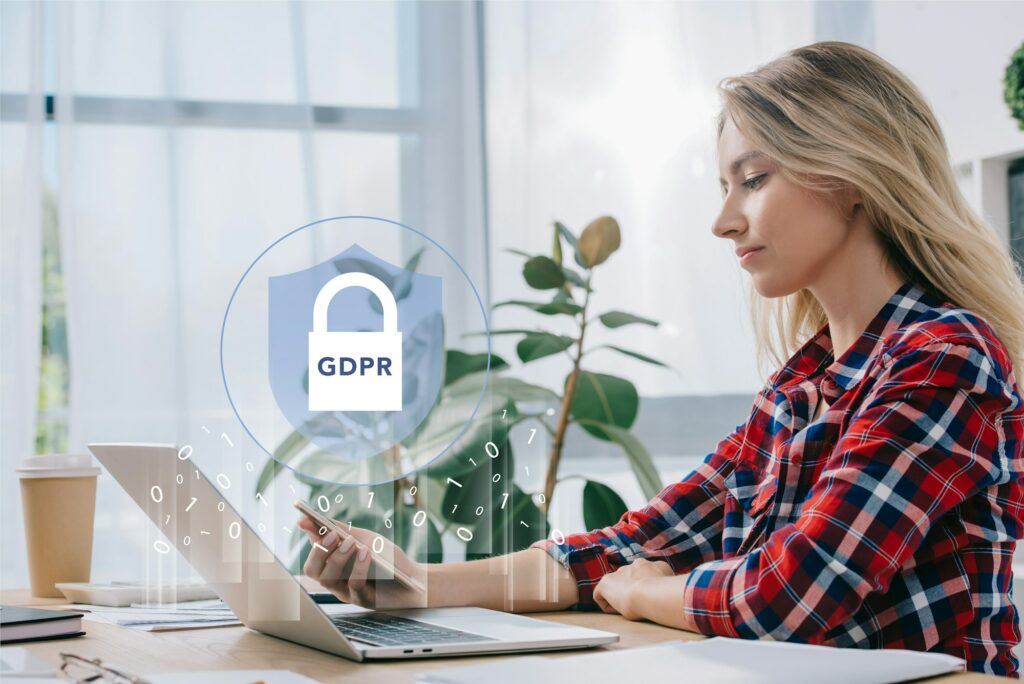Imagine you’re preparing for a big email marketing campaign. You’ve spent hours crafting compelling content, carefully segmenting your lists, and designing stunning visuals. But just as you’re about to hit the send button, a question crosses your mind – “Am I GDPR compliant?”.
In today’s digital age, the importance of understanding and complying with the General Data Protection Regulation (GDPR) cannot be overstated. GDPR affects not only businesses within the European Union but also those outside who handle EU citizens’ data.

Understanding GDPR can be a complex issue, particularly when navigating the realm of email marketing. However, when done right, you can turn it into an opportunity to build deeper trust with your customers. This article aims to explore the best practices for ensuring GDPR compliance in email marketing and helping you navigate this digital landscape confidently.
Understanding the Basics: Whats is GDRP: General Data Protection Regulation
The General Data Protection Regulation, better known as GDPR, represents a transformative shift in the way the personal data of European Union (EU) citizens is handled. This directive harmonizes data privacy laws in all EU member states, creating a firm foundation of protocol for the collection, utilization, storage, and deletion of personal data. It’s a robust set of guidelines aiming to bolster the protection of EU citizens’ personal data rights and build confidence in the digital ecosystem.
At its essence, the GDPR is all about enhancing personal data protection and increasing the control individuals have over their data. It fundamentally alters the guidelines of consent, empowering individuals with more rights to privacy. This legislation insists that organizations secure user data, making it not only safe but also simplifying processes for users to manage their data. In light of these privileges, it also enforces stringent penal provisions for non-compliance.

What makes this regulation particularly significant for businesses and organizations is the mandatory requirement of consent for data collection, clear communication about how data is being used, guaranteeing the right for data to be erased on an individual’s request, and prompt reporting in the event of a data breach.
To fully comply with GDPR guidelines, organizations must take active steps to protect personal data in all its forms, whether digital or physical and ensure safeguards are correctly put in place. Having a checklist for GDPR compliance is a helpful tool to measure the adherence of an organization to this regulation.

The Impact of GDPR on Email Marketing
- GDPR significantly influences all marketing endeavors, especially those involving email marketing. This is designed to give greater control to the individual over their personal data.
- When properly implemented, GDPR can enhance the efficiency of email marketing campaigns. This is identified through better engagement metrics like higher open rates and click-through rates.
- Acoustic’s 2021 Email Matters report offers concrete evidence supporting the positive influence of GDPR on marketing engagement metrics, further underlining its value in the field of email marketing.
- Email marketers have an important GDPR document called the Data Processing Addendum (DPA) at their disposal, covering vital requirements related to email marketing.
- To comply with GDPR in email marketing, transparency and clear consent agreements are crucial for new subscribers. It’s all about honest communication and obtaining informed consent.
- Email marketing is subject to several significant user rights under GDPR. These include the right to erasure (‘right to be forgotten’), right of access, breach notification, and right of portability of data.
- For GDPR-compliant email marketing, there’s no overemphasizing the importance of consumer transparency. This includes having clear data collection practices and updated privacy policies.
- Many email marketing software solutions now offer integrated tools to help marketers comply with various legislation, including GDPR and the California Consumer Privacy Act (CCPA).
The Impact of GDPR on Email Marketing
Understanding the impact of GDPR on email marketing necessitates a deep dive into how these new regulations affect data collection, handling, and consumer transparency. Several core user rights established under GDPR play an integral role in shaping email marketing strategies, such as the right to erasure, right of access, breach notification, and right of portability.

One of the primary changes introduced by GDPR is how email marketers handle consent. Precise consent agreements are no longer optional but a requirement, giving subscribers clearer insight into what they’re signing up for. Information must be straightforward and transparent, outlining what data is being captured, how it is processed, and how it is stored. The result of this is a significant improvement in how consumers perceive your brand and interact with your emails.
According to recent research, such as Acoustic’s 2021 Email Matters report, the impact of GDPR on email marketing is predominantly positive. The study found that campaigns that adhere to GDPR guidelines tend to see better engagement metrics, including open rates and click-through rates. This is good news for marketers, suggesting that ethical and transparent practices enforced by GDPR result in enhanced user interaction and engagement.
The rise of GDPR-compliant email marketing software offers marketers the necessary tools to track compliance, not only with GDPR but with other privacy laws like the California Consumer Privacy Act. These tools help marketers operationalize the key components of GDPR, ensuring that their email marketing tactics are on the right side of the law.

Ultimately, GDPR has mandated an environment where transparency is key – from outlining data collection practices to updating privacy policies. Regularly updating these policies and communicating them effectively to your subscribers is not just a part of maintaining GDPR compliance, but also an excellent strategy for building trust and loyalty among your audience.
How does GDPR affect email marketing?
One of the foremost ways GDPR influences email marketing is by implementing a rigid protocol to ensure your email subscribers are indeed interested and have willingly agreed to receive your emails. The principle here is building a solid foundation of trust and transparency with your subscribers, which, in turn, enhances the quality of your email campaigns.

The four things you should pay attention to in this scenario are:
- Explicit consent: GDPR mandates that every email subscriber must unequivocally agree to receive email communications from you. You need to clearly state what information is being collected and how it will be used.
- Double opt-in process: This method makes certain that your subscribers truly want to be on your list by asking them to confirm their subscription, usually via a confirmation email. It acts as a second layer of consent.
- Easy Opt-Out: Subscribers should find it effortless to stop getting communication from you. Opt-out links in emails should be conspicuous and unsubscribing must be a simple process.
- No involuntary opt-ins: Pre-checked boxes are a no-go area in GDPR compliance. Consent forms must be defaulted to “No” or not answered.
Embedded within the GDPR are certain titular user rights such as the right of erasure, the right of access, the right to be informed about breaches, and the right of data portability. These rights mean users can request to see their stored data, invoke the right to ‘be forgotten’, be notified in case of data breaches, and migrate their data to another service provider.
Surprisingly, Acoustic’s 2021 Email Matters report indicates that adhering to GDPR can significantly improve engagement metrics like open rates and click-through rates. The report shows that these compliance practices end up yielding better quality leads rather than inhibiting email campaigns.

In conclusion, GDPR isn’t just a regulation you must comply with; it’s a framework that can help you build more effective and more personal email marketing strategies. Being GDPR compliant means putting your customers first, which is, after all, the goal of every email marketer.
Best Practices for GDPR Compliance in Email Marketing
- Get Consent: Consent should be free, specific, informed, and unambiguous. In terms of email marketing, this typically involves using double opt-in procedures. This means your subscriber will fill out a form to sign up for your emails and then confirm their subscription via an email you send them.
- Data Minimization: Only collect the data necessary to you. If you’re only sending out a newsletter, for instance, all you probably need is your subscriber’s email address and name.
- Transparency: Communicate your data handling practices openly. Your subscribers need to know why you’re collecting their data, how you’re using it, and how long you plan to retain it. This information is typically included in your privacy policy.
- Enable Unsubscribing: Include a clear and direct way for your subscribers to opt out of your emails. This can be as simple as an unsubscribe link in the footer of your emails.
No doubt, GDPR adds an extra layer of responsibility to businesses. However, remember that the end goal here is to protect user’s data and to ensure their privacy. In doing so, you’re not just keeping with regulations – you’re also building a brand that’s trustworthy and respectful of its customers.
| GDPR Impact | Email Marketing Strategy | Benefit to Business |
|---|---|---|
| Data Protection | Ensure security measures for subscribers’ data. | Builds brand credibility and consumer trust. |
| User Control over Data | Provide options for subscribers to control their data. | Enhances customer experience and increases retention. |
| Consumer Trust | Focused and personalized communication strategies. | Improves marketing campaign effectiveness. |
| Safe Storage of Data | Update and refine data storage practices. | Reduces potential for data breaches and subsequent brand damage. |
FAQ
What is the significance of consent in GDPR-compliant email marketing?
Consent is a crucial component of GDPR-compliant email marketing. It means that the individual has given clear permission for their personal data to be processed for a particular purpose. In the context of email marketing, the user should be informed about how their data will be used and should actively opt-in to receive emails. It’s important to record this consent and provide an easy way for users to withdraw their consent at any time. Pre-ticked boxes or implicit consent is a no-go under GDPR.
Can B2B email marketing be affected by GDPR rules?
Absolutely. The GDPR rules apply to any organization that processes personal data from EU citizens, regardless if it is B2B or B2C. Even if your business only engages in B2B email marketing, you will still need to obtain clear and explicit consent before emailing any contact at a business located in the EU or any EU citizen.
What is profiling and how is it impacted by GDPR?
Profiling is the automated processing of personal data to evaluate certain personal aspects of an individual. This might include an analysis of their preferences, behaviors, and personal preferences, often utilized in targeted marketing campaigns. Under GDPR, individuals have the right to object to profiling. This means you need to disclose if you are using profiling in your email marketing and give recipients an easy way to opt out.
Are there any particular items listed on a GDPR checklist that email marketers should pay special heed to?
In a GDPR checklist, email marketers should pay special attention to ensuring clear and explicit consent, data minimization (keeping only what’s necessary), maintaining records of consent, and time-bound data retention. Also critical are the rights of individuals (access, rectification, erasure, and objection to processing), data security measures, and data breach reporting.
Conclusion
Let’s dive right in to discuss the best practices for GDPR compliance in email marketing. Adhering to these rules can initially feel overwhelming, but don’t worry. Once you understand the requirements and make the necessary adjustments, your email marketing strategy will be stronger than ever. Not to mention, your customers will appreciate your dedication to their privacy. Here are the key takeaways you need to keep in mind.
“With every email you send, make sure you’re compliant with GDPR, not just to avoid fines but to build trust with your audience.”




